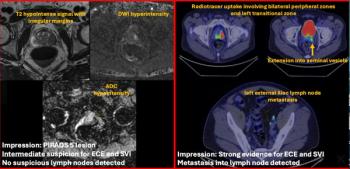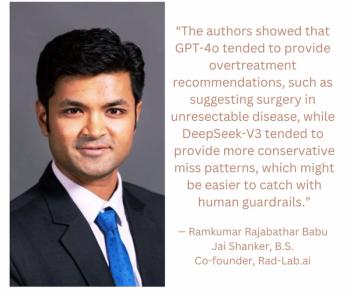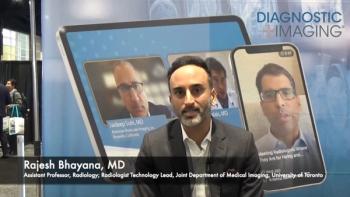
Report from ARRS: Three-T MR alone avoids complications of contrast-enhanced MR arthrography
A Duke University study has established that unenhanced 3T MR imaging can deliver the same diagnostic accuracy as contrast-enhanced 3T MR arthrography of the shoulder, but without the associated pain, radiation, and risk of adverse contrast reactions.
A Duke University study has established that unenhanced 3T MR imaging can deliver the same diagnostic accuracy as contrast-enhanced 3T MR arthrography of the shoulder, but without the associated pain, radiation, and risk of adverse contrast reactions.
The combined MRI-arthrography exam of suspicious shoulder labrum injury relies on fluoroscopy and iodine and gadolinium contrast media. Though considered highly accurate and efficacious, MR arthrography is too resource-intensive to remain desirable in today's busy radiology practice. The added radiation and use of contrast are also of concern to patients, said principal investigator Dr. Jeffrey Browne.
Three-T MR without intra-articular contrast injection can turn an invasive, lengthy, and potentially risky exam into a fast, diagnostically useful, and noninvasive one, according to Browne, a musculoskeletal radiology fellow at Duke during the study who is now a radiologist at Raleigh Radiology in North Carolina.
"Patients who are reluctant to undergo an arthrogram now have the option of undergoing a noninvasive exam while still allowing the radiologist to make an accurate diagnosis," Browne told Diagnostic Imaging.
In the study, 35 patients with shoulder pain underwent both unenhanced 3T MR and contrast-enhanced 3T MR arthrography. Results were interpreted blindly by three experienced musculoskeletal radiologists. Preliminary findings were reported at the 2008 American Roentgen Ray Society meeting in Washington, DC.
Nonenhanced and contrast-enhanced 3T MR detected a total of 27 and 31 labral tears, respectively. Arthrography detected 18 tears that were later confirmed by arthroscopic surgery in 14 of 15 patients who underwent the procedure. The sensitivity for nonenhanced and CE-MR at 3T was identical at 78%, while their specificity rates were 67% for the nonenhanced and 100% for the enhanced studies.
The sensitivity for each portion of the labrum was also identical on both MR techniques: superior 67%, anterior 100%, and posterior 86%. Interpretations of nonenhanced and CE-MR on 11 of the patients who underwent arthroscopy matched surgical results. Tears in four patients with discordant findings were inconsistently found on either MR technique.
Of the remaining 21 patients without surgical confirmation, 14 interpretations were identical between nonenhanced and CE-MR: eight with a normal labrum and six with tears. Of the seven patients with discordant findings, nonenhanced MR and CE-MR detected five and eight tears, respectively. None of the differences between either 3T MR technique for the diagnosis of labral pathology were statistically significant.
The addition of contrast into the shoulder joint altered management in few cases, suggesting contrast is not necessary when diagnosing glenoid labral pathology at 3T, according to Browne.
"Compared with 1.5T MR results, 3T's increased signal-to-noise and spatial resolution narrows the gap between conventional nonenhanced MR and CE-MR arthrography," he said.
The principal factor influencing the choice for conventional versus CE-MR arthrography is often the decision of orthopedic surgeons, Browne said.
Physician preference, however, should not be the only consideration. Several factors - the simplicity of conventional MR and avoidance of potential risks, cost, and patient preference - should also be taken into account. Most important, radiologists and referring surgeons should consider how imaging will alter patient management. Additional studies are needed to confirm preliminary findings so this technique catches on, he said.
"It may take some time to convince (surgeons) about the study's significance," Browne said. "I am hoping that when the study is published we may see a move toward conventional MR at 3T."
For more information from the Diagnostic Imaging archives:
Newsletter
Stay at the forefront of radiology with the Diagnostic Imaging newsletter, delivering the latest news, clinical insights, and imaging advancements for today’s radiologists.




























